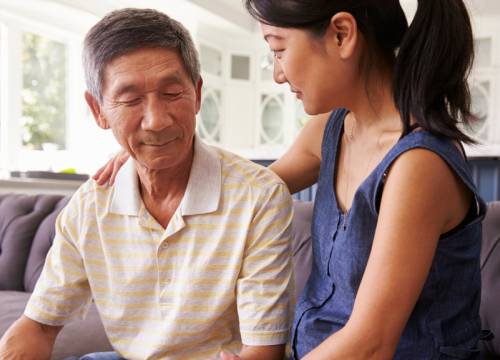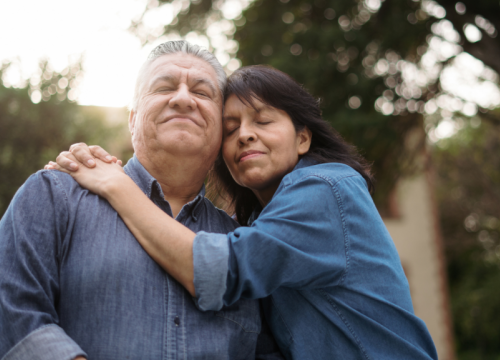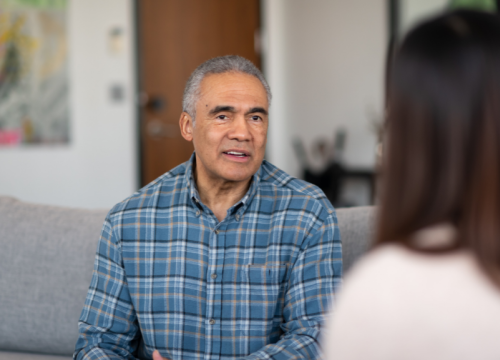Anxiety and PD
Like people with other chronic diseases, people with Parkinson’s disease (PD) often struggle with mental health. While the illness is known to impair many aspects of movement, research from the Parkinson’s Outcomes Project has found that two non-motor symptoms — depression and anxiety — play a key role in the disease and on people’s quality of life.
While feeling worried is an understandable reaction to a Parkinson’s diagnosis, when feelings of constant worry or nervousness go beyond a reasonable point, a person may experience anxiety, which is more serious.
Forms of Anxiety
Anxiety is a common non-motor symptom of PD. Anxiety is not simply a reaction to the diagnosis of Parkinson’s, but is instead a part of the disease itself, caused by changes in brain chemistry. Up to 40% people with PD will experience one of these forms of anxiety:
Generalized Anxiety Disorder (GAD) is characterized by feelings of nervousness and recurring thoughts of worry and fear. Physical symptoms that may accompany these feelings include butterflies in the stomach and nausea, trouble breathing or swallowing, racing of the heart, sweating and increased tremors.
Anxiety Attacks, or panic attacks usually start suddenly with a sense of severe physical and emotional distress. Individuals may feel as if they cannot breathe or are having a heart attack. These episodes usually last a few minutes to an hour, particularly when associated with “off” periods, though they can last for longer periods of time.
Social Avoidance, or social anxiety disorder, involves avoiding everyday social situations because of a fear of embarrassment caused by having having Parkinson’s symptoms, such as tremor, dyskinesias, or noticeable trouble walking in public.
Obsessive-Compulsive Disorder (OCD) may cause persistent, unwelcome thoughts or images (obsessions), and the urgent need to engage in certain rituals (compulsions) to try to control or rid themselves of these thoughts. Anxiety can begin before a PD diagnosis or develop much later on. While some people with PD experience anxiety on its own, many are diagnosed with anxiety along with depression. Anxiety is less well-studied than depression, but it may be just as common. If left unchecked, anxiety can worsen a person’s overall health condition.
Causes of Anxiety
Psychological Factors - Common fears and worries that go along with PD may trigger anxiety. One is a fear of being unable to function independently, particularly during a sudden “off” period (the time of day when medication is not working).
Biological Factors - Many of the brain pathways and chemicals affected by Parkinson’s are the same as those affected by anxiety and depression. In some cases, anxiety is directly related to changes in motor symptoms. Specifically, people who experience “off” periods can develop severe anxiety during these states, like anxiety attacks.
How Is Anxiety Diagnosed?
Anxiety is usually diagnosed by a primary care physician, or a mental health professional, who will ask questions about certain symptoms. The doctor usually asks questions about mood changes and behaviors. For people with an anxiety disorder, symptoms can become so intense that they are unable to function normally in life.
In general, symptoms of anxiety may include:
- Excessive fear and worry
- Uncontrollable or unwanted thoughts
- Sudden waves of terror
- Nightmares
- Ritualistic behaviors
- Problems sleeping
- Pounding heart
- Cold and sweaty hands
- Dizziness
- Nausea
In people with Parkinson’s, a diagnosis of an anxiety disorder is made only if the symptoms involve a clear change in a patient’s previous behavior and are not easily confused with motor symptoms. For example, even though there may be a legitimate concern that a tremor or change in walking ability may be noticed in public, a diagnosis of social avoidance is only made if the person realizes that the concern is excessive, the social situation is avoided, and it causes interference in the person’s social or work life.
Treating Anxiety
There are two main types of treatment options for anxiety: medications and psychological counseling (psychotherapy). Depending on the severity of symptoms, psychotherapy can be used alone or combination with medication. Care should be tailored to each person’s individual needs.
Psychotherapy
Psychotherapy or “talk therapy” refers to many varieties of counseling. This treatment can help people diagnosed with an anxiety disorder understand and better manage their symptoms. Psychotherapy offers two advantages: no drug side effects and coping skills that can be used over the long term.
Cognitive behavioral therapy (CBT) is effective at helping people change negative thinking patterns and behaviors to solve their problems and engage in life. CBT encourages people to develop more positive thoughts about themselves, the environment around them and their future: in this case the outcome related to their illness.
Counseling sessions can provide vital support, understanding and education. People with PD may be seen alone, as a couple or family, or in a group.
Non-Conventional Therapies for Anxiety
- Relaxation techniques
- Massage therapy
- Acupuncture
- Aromatherapy
- Meditation
- Music therapy
Tips for Living with Anxiety
- Educate yourself about PD and its symptoms, including anxiety.
- Keep a diary of your moods, medications and PD symptoms.
- Figure out what triggers your anxiety.
- Talk with your doctor about anxiety.
- Tell your care partner and family members how you are feeling, so they can understand your emotions better and help you cope.
- Find a support group for people with PD.
- Be flexible in your approaches to coping with anxiety; try different approaches.
- Understand that symptoms change; if a coping strategy stops working, try a new approach.
- Know that everyone experiences anxiety differently.
Call our Helpline for more information at 1-800-4PD-INFO (473-4626).
Related Materials
Episode 84: Managing Anxiety with PD
Expert Briefing: Mental Health and PD
Depression and PD: A Non-Drug Treatment Option
Related Blog Posts

Mental Health Tips for Cognition, Mood and Sleep

How to Advocate for Your Mental Health with Parkinson’s
